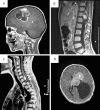Molecular characterization of paediatric glioneuronal tumours with neuropil-like islands: a genome-wide copy number analysis
- PMID: 28042510
- PMCID: PMC5199764
Molecular characterization of paediatric glioneuronal tumours with neuropil-like islands: a genome-wide copy number analysis
Abstract
Paediatric glioneuronal tumour with neuropil-like islands (GTNI) is a rare neoplasm of neuronal differentiation and diffusely infiltrating astroglial and oligodendrocyte-like components. The 2007 World Health Organization classification of central nervous system tumours considered it as a pattern variation of anaplastic astrocytoma. There are few data on paediatric GTNI probably both for their rarity and variable clinical aggressiveness. We studied by SNP/CGH array four tumour samples of GTNI from two males and two females (one new-born and three children aged from 4 to 8 years), in order to identify any possible common genomic alteration. All patients received chemo- and radiotherapy after their surgical treatment. No genomic instability nor recurrent alterations have been demonstrated in two of our GTNI cases. In the remaining two, we detected a mosaic trisomy 8 (15-20%) in one case, and an amplification at 5q14.1 involving DMGDH (partially), BHMT2 and BHMT genes, with the distal breakpoint falling at 23 Kbp from the 5'UTR of JMY, a p53 cofactor. Although the smallness of the sample impairs any clinical-histological correlation, GTNI appear different at the molecular level, with genomic imbalances playing a possible role in at least part of them. Our work gives an important contribution in knowledge and classification of this family of tumours.
Keywords: Database of Genomic Variants (DGV); Glioneuronal tumour with neuropil-like islands (GTNI); SNP/CGH array; amplification; central nervous tumours (CNS); common genomic alteration; copy number variations (CNVs); mosaicism; paediatric brain tumours; variation of anaplastic astrocytoma.
Figures



Similar articles
-
Disseminated glioneuronal tumor with neuropil-like islands of the spinal cord: a distinctive entity.World Neurosurg. 2013 Nov;80(5):655.e1-5. doi: 10.1016/j.wneu.2013.02.029. Epub 2013 Feb 9. World Neurosurg. 2013. PMID: 23403348 Review.
-
[Glioneuronal tumor with neuropil-like island: report of four cases and review of literature].Zhonghua Bing Li Xue Za Zhi. 2016 May 8;45(5):324-8. doi: 10.3760/cma.j.issn.0529-5807.2016.05.008. Zhonghua Bing Li Xue Za Zhi. 2016. PMID: 27142914 Review. Chinese.
-
Glioneuronal tumor with neuropil-like islands (GTNI): a report of 8 cases with chromosome 1p/19q deletion analysis.Am J Surg Pathol. 2007 Aug;31(8):1196-202. doi: 10.1097/PAS.0b013e3180335f65. Am J Surg Pathol. 2007. PMID: 17667543
-
Cytogenetic study of glioneuronal tumor with neuropil-like islands: a case report.Neuropathology. 2010 Aug;30(4):420-6. doi: 10.1111/j.1440-1789.2009.01066.x. Epub 2009 Oct 21. Neuropathology. 2010. PMID: 19845863
-
ATRX loss in glioneuronal tumors with neuropil-like islands indicates similarity to diffuse astrocytic tumors.J Neurooncol. 2016 Oct;130(1):63-68. doi: 10.1007/s11060-016-2224-8. Epub 2016 Jul 28. J Neurooncol. 2016. PMID: 27469217
Cited by
-
Glioneuronal tumor with neuropil-like islands in the spinal cord: A case report and literature review.Medicine (Baltimore). 2022 May 13;101(19):e29237. doi: 10.1097/MD.0000000000029237. Medicine (Baltimore). 2022. PMID: 35583532 Free PMC article. Review.
References
-
- Teo JG, Gultekin SH, Bilsky M, Gutin P, Rosenblum M. A distinctive glioneuronal tumor of the adult cerebrum with neuropil-like (including “rosetted”) islands: report of 4 cases. Am J Surg Pathol. 1999;23:502–10. - PubMed
-
- Chesser JD, Friedman NR, Prayson RA. Congenital glioneuronal tumor with neuropil-like islands. J Clin NeuroscI. 2016;24:156–7. - PubMed
-
- Allende DS, Prayson RA. The expanding family of glioneuronal tumors. Adv Anat Pathol. 2009;16:33–9. - PubMed
LinkOut - more resources
Full Text Sources
Research Materials
Miscellaneous
